【Objective】 Continuous no-tillage effects on crop yield and soil fertility in double rice cropping system were studied in order to provide valuable references to technique selection of soil management and rice cast-transplantation for this cropping system in South China. 【Method】 No-tillage with cast-transplanting has been conducted in paddy field with double rice cropping system since 2005 in Nanchang city, Jiangxi Province. Crop yield and soil fertility indexes, such as density, porosity, water retention property, nutrient, microbe and enzymes activities were simultaneously determined in this study.【Result】 The early and later rice grain yield were 2.70% and 1.87% higher than that under conventional tillage, respectively, under no-tillage treatment of one and two years (four crops), but crop yield in different treatments was not different significantly. As the time of no-tillage prolonged,early and later rice grain yield decreased, particularly no-tillage of five years decreased by 9.16% and 12.56%. The no-tillage treatment of one year (two crops) improved soil physical properties, but as the time of no-tillage prolonged, worsened soil physical properties, the density was 1.68%-8.01% higher than that under conventional tillage,and the porosity decreased by 0.69%-4.48%,and non-capillary porosity decreased by 15.42%-37.92%. The no-tillage treatment helped nutrient enrichment in the surface soil layer, but decreased soil water retention property. Soil analysis showed that the no-tillage field was less than the control, plowed field in total amount of three groups of soil microbes. However, in no-tillage field, the amount of soil bacteria increased, while that of soil actinomyces and fungi decreased, and urease activity in surface layer soil increased. Significant positive correlations were observed in soil organic matter and total N with urease, catalase and polyphenol oxidase activity. Significant positive correlations of soil total N and available K with peroxidase activity were also obsearved. 【Conclusion】 In comparison to conventional tillage, crop yield in no-tillage treatment of one and two years (four crops) was not differ significantly, no-tillage treatment of one year improved soil physical properties, but as the time of no-tillage prolonged, worsened soil physical properties,early and late rice grain yield decreased. The no-tillage treatment helped nutrient enrichment in the surface soil layer, but decreased soil water-retention property. In no-tillage field, the amount of soil bacteria increased, while that of soil actinomyces and fungi decreased, and urease activity in surface layer soil increased.









